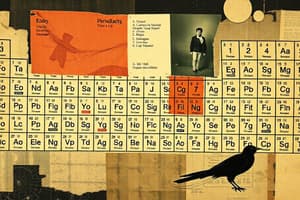Podcast
Questions and Answers
Elements Y and X are compared. Element Y has a larger radius than Element X. Based on this, you could say:
Elements Y and X are compared. Element Y has a larger radius than Element X. Based on this, you could say:
- Element Y is further to the left side of the periodic table.
- Elements Y and X are probably in the same group.
- A and B are correct. (correct)
- Element X is closer to the top of the periodic table.
Atomic radius generally increases as elements move:
Atomic radius generally increases as elements move:
- down a group and from left to right across a period
- down a group and from right to left across a period (correct)
- up a group and from right to left across a period
- up a group and from left to right across a period
The atomic radius of main-group elements generally increases down a group because the:
The atomic radius of main-group elements generally increases down a group because the:
- effective nuclear charge decreases down a group
- effective nuclear charge increases down a group
- effective nuclear charge zigzags down a group
- the principal quantum number of the valence orbitals increases (correct)
Which one of the following atoms has the largest radius?
Which one of the following atoms has the largest radius?
Which one of the following atoms has the largest radius?
Which one of the following atoms has the largest radius?
Which one of the following atoms has the smallest radius?
Which one of the following atoms has the smallest radius?
Which one of the following atoms has the largest radius?
Which one of the following atoms has the largest radius?
Which one of the following elements has the largest atomic radius?
Which one of the following elements has the largest atomic radius?
Which one of the following elements has the largest atomic radius?
Which one of the following elements has the largest atomic radius?
In which of the following atoms is the 2s orbital closest to the nucleus?
In which of the following atoms is the 2s orbital closest to the nucleus?
Which of the following correctly lists the five atoms in order of increasing size (smallest to largest)?
Which of the following correctly lists the five atoms in order of increasing size (smallest to largest)?
In which of the following atoms is the 3s orbital closest to the nucleus?
In which of the following atoms is the 3s orbital closest to the nucleus?
Which of the following correctly lists the five atoms in order of increasing size (smallest to largest)?
Which of the following correctly lists the five atoms in order of increasing size (smallest to largest)?
The ability of an atom in a molecule to attract electrons is best quantified by the atom's:
The ability of an atom in a molecule to attract electrons is best quantified by the atom's:
Electronegativity ______ from left to right within a period and ______ from top to bottom within a group.
Electronegativity ______ from left to right within a period and ______ from top to bottom within a group.
Of the atoms below, ______ is the most electronegative.
Of the atoms below, ______ is the most electronegative.
Of the atoms below, ______ is the most electronegative.
Of the atoms below, ______ is the most electronegative.
Of the atoms below, ______ is the least electronegative.
Of the atoms below, ______ is the least electronegative.
Which of the elements below has the largest electronegativity?
Which of the elements below has the largest electronegativity?
In general, as you go across a period in the periodic table from left to right: the atomic radius ______; the electronegativity ______; and the first ionization energy ______.
In general, as you go across a period in the periodic table from left to right: the atomic radius ______; the electronegativity ______; and the first ionization energy ______.
The first ionization energies of the elements ______ as you go from left to right across a period of the periodic table, and ______ as you go from the bottom to the top of a group in the table.
The first ionization energies of the elements ______ as you go from left to right across a period of the periodic table, and ______ as you go from the bottom to the top of a group in the table.
Of the choices below, which gives the order for first ionization energies?
Of the choices below, which gives the order for first ionization energies?
Of the following atoms, which has the largest first ionization energy?
Of the following atoms, which has the largest first ionization energy?
Of the following elements, which has the largest first ionization energy?
Of the following elements, which has the largest first ionization energy?
Of the following elements, which has the largest first ionization energy?
Of the following elements, which has the largest first ionization energy?
Of the following elements, which has the largest first ionization energy?
Of the following elements, which has the largest first ionization energy?
Of the following elements, which has the largest first ionization energy?
Of the following elements, which has the largest first ionization energy?
Of the elements below, ______ has the largest first ionization energy.
Of the elements below, ______ has the largest first ionization energy.
______ have the lowest first ionization energies of the groups listed.
______ have the lowest first ionization energies of the groups listed.
Which equation correctly represents the first ionization of aluminum?
Which equation correctly represents the first ionization of aluminum?
Which of the following correctly represents the second ionization of aluminum?
Which of the following correctly represents the second ionization of aluminum?
Which equation correctly represents the first ionization of phosphorus?
Which equation correctly represents the first ionization of phosphorus?
Which of the following correctly represents the second ionization of phosphorus?
Which of the following correctly represents the second ionization of phosphorus?
Which equation correctly represents the first ionization of barium?
Which equation correctly represents the first ionization of barium?
Which of the following correctly represents the second ionization of calcium?
Which of the following correctly represents the second ionization of calcium?
Of the elements below, ______ is the most metallic.
Of the elements below, ______ is the most metallic.
The list that correctly indicates the order of metallic character is ______.
The list that correctly indicates the order of metallic character is ______.
Between which two elements is the difference in metallic character the greatest?
Between which two elements is the difference in metallic character the greatest?
What is the effective nuclear charge on a valence electron in Se?
What is the effective nuclear charge on a valence electron in Se?
What is the effective nuclear charge on a valence electron in Cs?
What is the effective nuclear charge on a valence electron in Cs?
What is the effective nuclear charge on a valence electron in B?
What is the effective nuclear charge on a valence electron in B?
What is the effective nuclear charge on a valence electron in Pb?
What is the effective nuclear charge on a valence electron in Pb?
A valence electron in which of the following elements has the highest effective nuclear charge?
A valence electron in which of the following elements has the highest effective nuclear charge?
A valence electron in which of the following elements has the highest effective nuclear charge?
A valence electron in which of the following elements has the highest effective nuclear charge?
Flashcards
Atomic Radius Trend
Atomic Radius Trend
Atomic radius generally increases down a group and from right to left across a period.
Effective Nuclear Charge
Effective Nuclear Charge
The net positive charge experienced by a valence electron, taking into account shielding.
Shielding Effect
Shielding Effect
Inner electrons reduce the nuclear pull on valence electrons.
Electronegativity Trend
Electronegativity Trend
Signup and view all the flashcards
Metallic Character
Metallic Character
Signup and view all the flashcards
First Ionization Energy
First Ionization Energy
Signup and view all the flashcards
Ionization Energy Trend
Ionization Energy Trend
Signup and view all the flashcards
Atomic Radius
Atomic Radius
Signup and view all the flashcards
Electronegativity
Electronegativity
Signup and view all the flashcards
Period
Period
Signup and view all the flashcards
Group (Family)
Group (Family)
Signup and view all the flashcards
Valence Electron Trend
Valence Electron Trend
Signup and view all the flashcards
Effective Nuclear Charge Trend
Effective Nuclear Charge Trend
Signup and view all the flashcards
Group 1 Elements
Group 1 Elements
Signup and view all the flashcards
Group 17 Elements
Group 17 Elements
Signup and view all the flashcards
Study Notes
Effective Nuclear Charge & Periodic Trends
-
Element Radius & Periodic Table Position: If element Y has a larger radius than element X, Y is likely further left on the periodic table and X closer to the top. Elements Y and X might be in the same group.
-
Atomic Radius Trends: Atomic radius generally increases going down a group and from right to left across a period.
-
Main-Group Atomic Radius Increase: The atomic radius of main-group elements increases down a group because the principal quantum number of the valence orbitals increases.
-
Multiple Choice Questions (Examples): Elements with larger atomic radii are found further left and/or toward the bottom of the periodic table. The 2s orbital is found closer to the nucleus in lighter elements.
-
Electronegativity Trends: Electronegativity increases from left to right across a period and from bottom to top of a group.
-
Electronegativity Examples: Fluorine (F) is the most electronegative element. Rubidium (Rb) is a less electronegative element than Chlorine (Cl).
-
Ionization Energy Trends: Ionization energy generally increases from left to right across a period and from bottom to top of a group.
-
Ionization Energy Examples: Elements with higher ionization energies are more difficult to remove electrons from. Elements further right in a period, have higher ionization energies.
-
Factors Affecting Effective Nuclear Charge: Effective nuclear charge increases going across a period from left to right, while it is fairly constant down within a group.
-
Effective Nuclear Charge Examples: The effective nuclear charge of an element is the positive charge of the nucleus that an electron feels. Specific examples of effective nuclear charges are stated with the elements in other questions. For example, an element like Lead (Pb) has a higher effective nuclear charge from left to right in the periodic table.
Studying That Suits You
Use AI to generate personalized quizzes and flashcards to suit your learning preferences.




